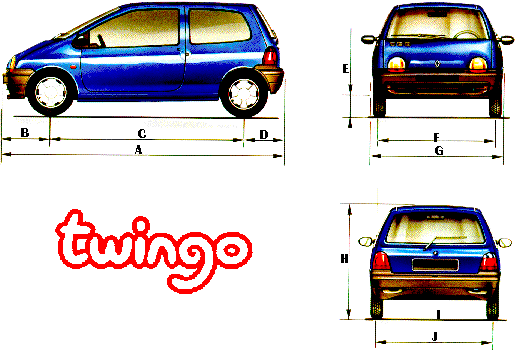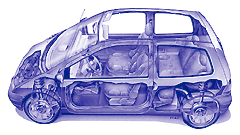
 Twingo Specs
Twingo Specs
![]() Either you love this car, either you hate it, but you can't consider Twingo
without having an opinion. It's not just a car, it's a philosophy of life.
This is a car to experience, not just to drive. In 30 years from now, it
will be part of the scenery and a symbol of it's era, just like the VW
Beetle, Mini, Renault 4L or Citroen
2CV.
Either you love this car, either you hate it, but you can't consider Twingo
without having an opinion. It's not just a car, it's a philosophy of life.
This is a car to experience, not just to drive. In 30 years from now, it
will be part of the scenery and a symbol of it's era, just like the VW
Beetle, Mini, Renault 4L or Citroen
2CV.

![]() In addition to Twingo's special look, its interior is what makes it's originality.
Twingo is the shortest car of its category, but its interior is the largest
. It is probably the smallest minivan/MPV with a special philosophy : "une
voiture à vivre". Its other main features are the huge digital LCD
in the middle of the dashboard and the famous modular back seats :
In addition to Twingo's special look, its interior is what makes it's originality.
Twingo is the shortest car of its category, but its interior is the largest
. It is probably the smallest minivan/MPV with a special philosophy : "une
voiture à vivre". Its other main features are the huge digital LCD
in the middle of the dashboard and the famous modular back seats :
- Slide them back and you have more leg space than in a Safrane. Only the trunk gets smaller.
- Slide them forward, and you have more space for luggage than in any other car of it's size. And there's still enough room for small passengers.
- With both front and back seats tilted backwards, Twingo's interior turns into a double bed.
- Completely fold the seats and the Twingo turns into a delivery van.

![]() Click HERE to see pictures about Twingo's seats and engine.
Click HERE to see pictures about Twingo's seats and engine.
![]() You can find many informations about the Twingo (and ask all questions you want) on the Yahoo! Club Twingo.
You can find many informations about the Twingo (and ask all questions you want) on the Yahoo! Club Twingo.
Measurements :

| A | Total Length | 135" | 3,43m |
| G | Total Width | 62.2" | 1,63m |
| H | Height | 55.9" | 1,42m |
| Weight | 1796 or 1893 lbs | 815 to 850 Kg | |
| Modular Trunk | 5.5 to 38.7 cubic feet | 168 to 1096dm3 | |
| Petrol/Gas tank | 11 Gallons | 40 litres | |
| Aerodynamics | Cx 0,35/SCx 0,695 | Cx 0,35/SCx 0,695 |
Performance :

"Cleon" C3G Engine
| Engine | 4cyl., 1239cc |
| 0-60mph - 0-100km/h | 14.0 sec |
| 1/4 Mile - 400m | 18.9 sec |
| Top Speed | 93mph - 151km/h |
| Power | 55 bhp @ 5300 rpm |
| Torque | 66lb-ft - 90Nm @ 2800 rpm |
| Injection | monopoint |
| Transmission | Front WD - 5 sp. manual or semi-auto (Easy) |
| 55mph - 90km/h | 46 mpg - 5,1 l/100km |
| City | 32 mpg - 7,4 l/100km |
New D7F Engine
| Engine | 4cyl., 1149cc, 8V |
| 0-60mph - 0-100km/h | 13.4 sec (Easy:14,4 Matic:16,4) |
| 1/4 Mile - 400m | 18.8 sec (Easy:19,8 Matic:20,5) |
| Top Speed | 94mph - 150km/h |
| Power | 60 bhp @ 5250 rpm |
| Torque | 93Nm-2500tr/mn |
| Injection | Sequential Multipoint |
| Transmission | Front WD - 5 sp. manual or semi-auto (Easy) or 3 sp. auto. ('Matic) |
| 55mph - 90km/h | 49 mpg - 4,8 l/100km |
| City | 36 mpg - 6,5 l/100km |
New D4F Engine
| Engine | 4cyl., 1149cc, 16V |
| 0-60mph - 0-100km/h | 11.7 sec |
| 0-1000m | 33.7 sec |
| Top Speed | 170km/h |
| Power | 75 bhp @ 5500 rpm |
| Torque | 105Nm-3500tr/mn |
| Injection | Sequential Multipoint |
| Transmission | Front WD - 5 sp. manual or semi-auto (Easy) or 3 sp. auto. ('Matic) |
| Highway | 4,9 l/100km |
| City | 7,5 l/100km |
Safety :
Links :
- Crash test Euroncap (2003)
- Twingo crash test with a Laguna : crashtest.mov, 445 Kb
![]() Despite being only 3.43 m. long, the Twingo therefore offers a high level
of safety, even in collisions with vehicles of significantly greater weight.
Despite being only 3.43 m. long, the Twingo therefore offers a high level
of safety, even in collisions with vehicles of significantly greater weight.
![]() The Twingo 2 is equipped with a reinforced lower structure with longerons
of greater thickness and different cross-section, a thicker floor panel,
stiffeners for the tunnel (forward section) and the sill sections (of omega
section), and steering column support flanges. The upper part of the structure
has also been modified with stiffeners for the front inner wings and the
door frames (of omega section), and inner panels for the front pillars
and the rear quarters. Altogether, Twingo uses an extra 30 kg of high-strength
steel in its structure.
The Twingo 2 is equipped with a reinforced lower structure with longerons
of greater thickness and different cross-section, a thicker floor panel,
stiffeners for the tunnel (forward section) and the sill sections (of omega
section), and steering column support flanges. The upper part of the structure
has also been modified with stiffeners for the front inner wings and the
door frames (of omega section), and inner panels for the front pillars
and the rear quarters. Altogether, Twingo uses an extra 30 kg of high-strength
steel in its structure.
![]() The Twingo 2 is also equipped with high performance occupant retention
systems to offset the effects of the greater deceleration resulting from
the greater stiffness of the structure. As a new feature at this market
level, the Twingo 2 is equipped with the Renault SRP (System for Restraint
and Protection) with programmed restraint airbags, safety belt pretensioners,
load limiters for the front and rear seats, and close-contact head restraints
with curved runners.
The Twingo 2 is also equipped with high performance occupant retention
systems to offset the effects of the greater deceleration resulting from
the greater stiffness of the structure. As a new feature at this market
level, the Twingo 2 is equipped with the Renault SRP (System for Restraint
and Protection) with programmed restraint airbags, safety belt pretensioners,
load limiters for the front and rear seats, and close-contact head restraints
with curved runners.
![]() Thanks to a control valve which allows pressure in the airbag to be adjusted
during the deceleration phase, the programmed restraint airbag achieves
levels of energy absorption and damped movement impossible with conventional
airbags. In addition, this airbag protects and damps movement of both head
and chest. During deceleration, the load exerted on the latter by the belt
is reduced to only 400 kg, compared with the usual 900 kg. In this way
the Twingo achieves a performance unique in its market segment.
Thanks to a control valve which allows pressure in the airbag to be adjusted
during the deceleration phase, the programmed restraint airbag achieves
levels of energy absorption and damped movement impossible with conventional
airbags. In addition, this airbag protects and damps movement of both head
and chest. During deceleration, the load exerted on the latter by the belt
is reduced to only 400 kg, compared with the usual 900 kg. In this way
the Twingo achieves a performance unique in its market segment.
![]() This system can be completed by specifying combined head and chest side
airbags, another completely new feature for a car in this class. Equipped
with control valves to regulate inflation pressure, the bags provide improved
protection for both head and chest compared with conventional side airbags.
This system can be completed by specifying combined head and chest side
airbags, another completely new feature for a car in this class. Equipped
with control valves to regulate inflation pressure, the bags provide improved
protection for both head and chest compared with conventional side airbags.
Last update : May 22, 2006.
Number of connexions since
June 30, 2000 :

